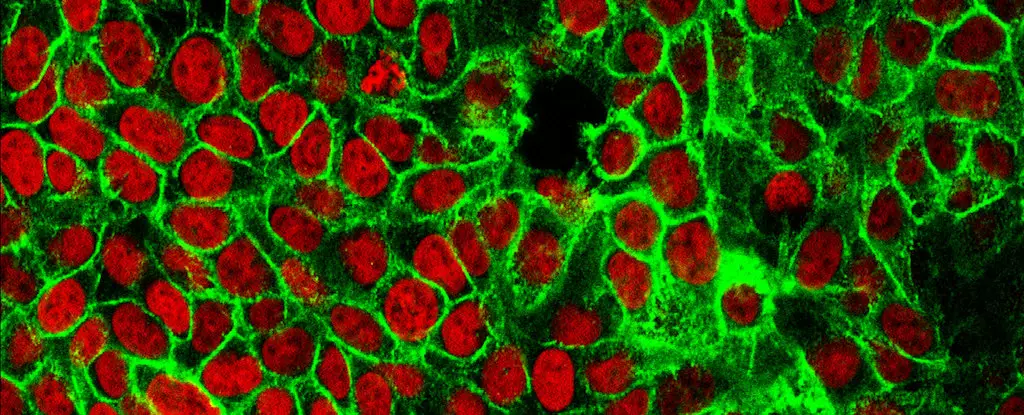Cancer is one of the leading causes of death globally, claiming the lives of more than 10 million individuals annually. Despite the grim statistics, many cancers are treatable if detected early and managed effectively. The challenge often lies in the elusive nature of cancer, making it difficult for timely diagnosis and intervention. Recent research has uncovered a promising avenue for identifying ‘fingerprints’ of cancer at an atomic level, leveraging a technique primarily used in geology. This breakthrough has the potential to revolutionize the investigation of cancer growth and enhance early detection methods.
Lead author Ashley Maloney, a biogeochemist at the University of Colorado Boulder, and her team from the United States and Switzerland embarked on a groundbreaking study to explore the distribution of hydrogen isotopes at a cellular level. By capitalizing on natural variations in hydrogen isotopes, particularly deuterium, they aimed to investigate the metabolic differences in cells with high growth rates, such as cancer cells. The revelation that hydrogen isotopes could offer insights into cellular metabolism opens up new possibilities for understanding cancer progression and developing innovative diagnostic tools.
In their laboratory experiments, the researchers cultured yeast and mouse liver cells to analyze their hydrogen isotopic composition. They discovered that cells exhibiting rapid growth rates, akin to cancer cells, displayed a distinct ratio of hydrogen to deuterium. This observation hints at the potential utility of hydrogen isotopes as indicators of abnormal cellular metabolism, particularly in the context of cancer development. While the findings are preliminary and require further investigation, the implications for early cancer detection are profound.
One of the key insights from the study is the metabolic shift towards fermentation in highly proliferative cells, including cancer cells. The Warburg effect, characterized by increased reliance on fermentation for energy production, is a hallmark of many cancers. By monitoring metabolic anomalies associated with fermentation, scientists can potentially identify early signs of cancerous growth. The researchers aimed to track these metabolic changes by examining hydrogen isotopes, which play a crucial role in cellular respiration and fatty acid production.
By analyzing the fatty acids of yeast colonies and mouse liver cells, Maloney and her team determined the hydrogen isotopic ratios using a mass spectrometer. Surprisingly, fermenting yeast cells, acting as cancer cell proxies, exhibited a significant reduction in deuterium atoms compared to normal cells. This distinct isotopic signature serves as a promising indicator of metabolic alterations associated with cancer. The parallels between planetary health tracking and disease monitoring underscore the potential for hydrogen isotopes to revolutionize cancer detection.
The ability to detect subtle changes in hydrogen isotopic composition could pave the way for non-invasive and early cancer screening methods. Co-author Sebastian Kopf, a geological scientist at the University of Colorado Boulder, emphasizes the importance of early cancer detection in improving patient outcomes. The strong correlation between metabolic shifts and cancer progression highlights the transformative potential of hydrogen isotopes as diagnostic biomarkers. As research advances in this field, the prospect of leveraging isotopic signals for cancer detection becomes increasingly feasible.
Looking ahead, further studies are warranted to validate the utility of hydrogen isotopes in diagnosing cancer and monitoring treatment responses. The interdisciplinary collaboration between geologists and medical researchers offers a unique perspective on utilizing geosciences tools for biomedical applications. Co-author Xinning Zhang, an environmental microbiologist at Princeton University, underscores the significance of this cross-disciplinary approach in expanding our understanding of health and disease tracking.
The discovery of hydrogen isotopes as potential ‘fingerprints’ of cancer at an atomic level represents a significant advancement in cancer research. By elucidating the metabolic alterations associated with cancer cells, researchers are paving the way for innovative diagnostic strategies and personalized treatment interventions. The intersection of geology and medicine in this research highlights the transformative power of interdisciplinary collaboration in addressing complex health challenges. As we delve deeper into the realm of hydrogen isotopes and cancer biology, the future holds promise for early cancer detection and improved patient outcomes.


Leave a Reply